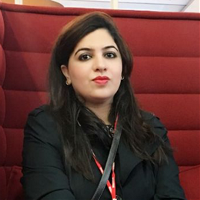Articles
Treasury Profile: Leading Corporate Treasury in Pakistan
- By AFP Staff
- Published: 3/24/2022
 When Saima Jamil joined Transworld Associates in 2013, she took a job in the finance division where she dealt with the banks and related matters. At that point in time, the finance department was small and there was no formal treasury role, even though treasury activities were happening. The company started to expand and massively enhanced its core projects to the point where a formal treasury department was established. Because the company was engaged in arranging syndicate finance facilities, the number of banks and operational activities increased as well. They then decided to divide the treasury role into two sections: operations and finance. Jamil managed the operations side for a few years, and has since taken on many of the finance activities too, becoming the official manager of Treasury and Finance for the company. “I have seen the treasury department evolve from a small-scale operation to a proper functional department,” said Jamil.
When Saima Jamil joined Transworld Associates in 2013, she took a job in the finance division where she dealt with the banks and related matters. At that point in time, the finance department was small and there was no formal treasury role, even though treasury activities were happening. The company started to expand and massively enhanced its core projects to the point where a formal treasury department was established. Because the company was engaged in arranging syndicate finance facilities, the number of banks and operational activities increased as well. They then decided to divide the treasury role into two sections: operations and finance. Jamil managed the operations side for a few years, and has since taken on many of the finance activities too, becoming the official manager of Treasury and Finance for the company. “I have seen the treasury department evolve from a small-scale operation to a proper functional department,” said Jamil.
The responsibilities and key skills of a corporate treasurer
Saima describes Transworld Associates as a mid-sized private company in the service industry sector. In terms of her responsibilities, “The most important aspect is managing working capital and arranging medium- and long-term loans,” she said.  According to Saima, Transworld believes in optimizing the utility of funds by investing them in the money market and by making sure that access to facility lines is readily available for the short term. The other major task that requires her focus is maintaining the relationship her company has with the 12+ banks with which it does business, including attending to each one’s compliance requirements, tax and regulatory requirements, and day-to-day matters of internal and external stakeholders.
According to Saima, Transworld believes in optimizing the utility of funds by investing them in the money market and by making sure that access to facility lines is readily available for the short term. The other major task that requires her focus is maintaining the relationship her company has with the 12+ banks with which it does business, including attending to each one’s compliance requirements, tax and regulatory requirements, and day-to-day matters of internal and external stakeholders. When we asked Saima what skills she recommends for a career in treasury, she had this to say: “Treasury is altogether a specialized field, and, as a corporate treasurer, there are certain key skills that are necessary to do the job well. For example, while arranging financing, having negotiation skills helps in getting favorable covenants, better spread rates and avoiding unnecessary fees.”
Communication is a challenge
The biggest challenge Saima faces in her current role comes from a communication gap that exists both internally and externally. Externally, the communication channels between their financial institutions and the corresponding countries’ regulatory bodies are less than free flowing. “Most of the time when we’re seeking approval for cross-border payments, the process gets delayed due to either a new regulatory requirement, which we’re informed of after the case submission, or the regulator takes too much time to respond to the corresponding banks,” said Saima.Internally, the delegation of authority from management is sometimes challenging. For money market investments, every penny can earn a return if the treasury manager has the authority to make and mature investments overnight. This is not possible if the authority is restricted and subject to availability of signatories, thus limiting the opportunity to earn better returns. The same is true for the inflow of their remittance; the bank requires a list of documents, which then delays the recovery credit in their account, delaying the cash conversion cycle. “It can be really frustrating,” said Saima.
Interested in becoming a Certified Treasury Professional? Download same test questions and prep guide. It contains strategies and test taking tips to help you better prepare for the CTP exam. Sample questions, with answer key, are included. Download it here.
If it were up to Saima, she would institute a uniform process across the banking industry for corporate clients, which could be adapted at a global level. “It wouldn’t necessarily be 100% uniform across the world as the regulatory body in each country has its own requirements and limitations, but overall, the approach can be harmonized,” she said.Additionally, there should be a defined timeline for each part of the process to respond, added Saima. “Corporates should be able to view the progress of their cases through banking portals as delays sometimes result in losing important deals,” she said.
Change your mind and the rest will follow
“Technology skills are the future,” said Saima. “The scope of what technology can do for us in treasury is tremendous.” At the height of the coronavirus pandemic, Saima saw developing countries, such as her home of Pakistan, adopt ‘new norms.’ “The work from home situation, particularly in regard to treasury’s operational activities, created the need to adopt a robust system. There is still a lot of room for improvement, but we’re evolving.”The automation of treasury dashboards is something Saima is looking forward to as it would help generate one-click cash position reports and other outstanding obligations in current time. She is also striving for automation of their AP and AR modules with bank recons to provide her team with real-time data.
“There is also a need for the adoption of hedging techniques,” said Saima. “Most organizations are only opting for natural hedging, but there is a need to understand and gain more insight of other techniques as the U.S. dollar is playing a dominant role in the economy of our country and has a direct impact on our financial results.”
Saima feels that the future of treasury goes beyond upskilling to a new frame of mind. Larger, more mature organizations regard the treasury department with a level of importance not necessarily seen in mid-size and small organizations, she said. “Ideally, organizations should realize that treasury holds a strategic importance directly and indirectly; everything that happens in an organization is subject to the availability of funds.” CapEx projects can only be executed if the facility lines are accessible. And because treasury plays a role in strategic decisions such as cost savings, budgeting and planning, better financial results can be attained by its involvement.
Two approaches to professional growth
There are two approaches to professional growth, according to Saima. The first is to work a 9-5 job where you do the required tasks, work hard, earn money and hope for a progression. The second is to build a career by being passionate and proactive about your work, considering the tasks objectively, and meeting each day with a desire to learn more. “This is only possible when you love your job,” she said. “I am lucky to work in a place where my hard work rewarded me with a number of career progressions; however, it was my desire to enhance my core skills and to specialize in my field that led me to the CTP, which I earned it in first attempt.”Saima stated that the CTP holds international recognition in nearly all regions, and that the course content is comprehensive, covering the required knowledge in great detail. “While I was studying the course, I started feeling more confident about myself as a treasurer,” she said. “It was a learning curve experience for me. It gave me the understanding of products and concepts in practice in the U.S. and other developed counties. It also helped me to understand areas of treasury with which I had no experience. After passing the CTP exam, I am more confident about my knowledge and understanding of corporate treasury. I know that having the CTP has opened many doors for me at global level.”
Does she recommend the CTP to others? “I strongly recommend the CTP to all those candidates who are either working in a treasury department or who intend to work in treasury in the future,” said Saima. She added that being a corporate treasurer requires specific skill sets that can only be achieved by earning relevant certifications. “AFP’s CTP designation is one of the quickest, most comprehensive and relevant certifications that is accepted around the globe,” she said. “It is worth doing.”
Learn more about the corporate treasury profession through original content and resources available only on AFP’s website. You can also get started on your journey to earning the CTP here.
PARTNER CONTENT:
Copyright © 2024 Association for Financial Professionals, Inc.
All rights reserved.

![UMB Bank Vert Full Color CMYK[2] UMB Bank Vert Full Color CMYK[2]](/images/default-source/default-album/association_of_financial_professionals/umb-bank-vert-full-color-cmyk-2.png?sfvrsn=169a146b_1&MaxWidth=140&MaxHeight=140&ScaleUp=false&Quality=High&Method=ResizeFitToAreaArguments&Signature=27622428BC9C346FF684161B44C690104798350E)

.png?sfvrsn=2c6d166b_2&MaxWidth=80&MaxHeight=50&ScaleUp=false&Quality=High&Method=ResizeFitToAreaArguments&Signature=E38BCEACDE40B47D5C22BBB194B034137985F265)
